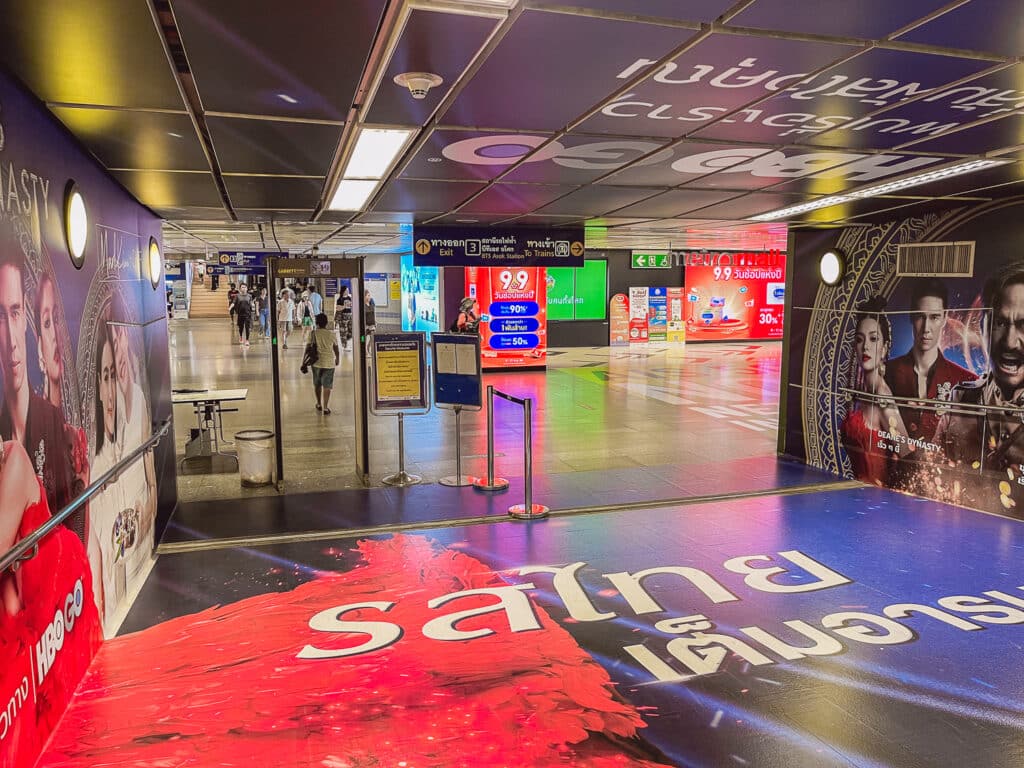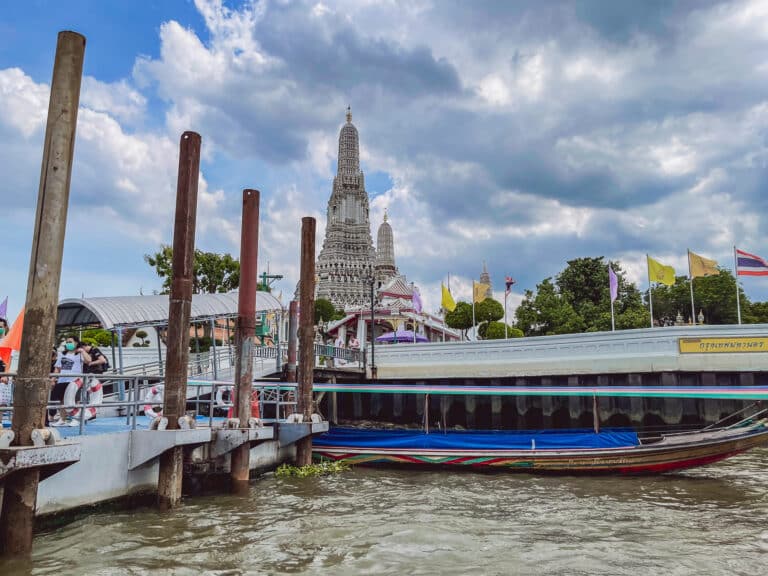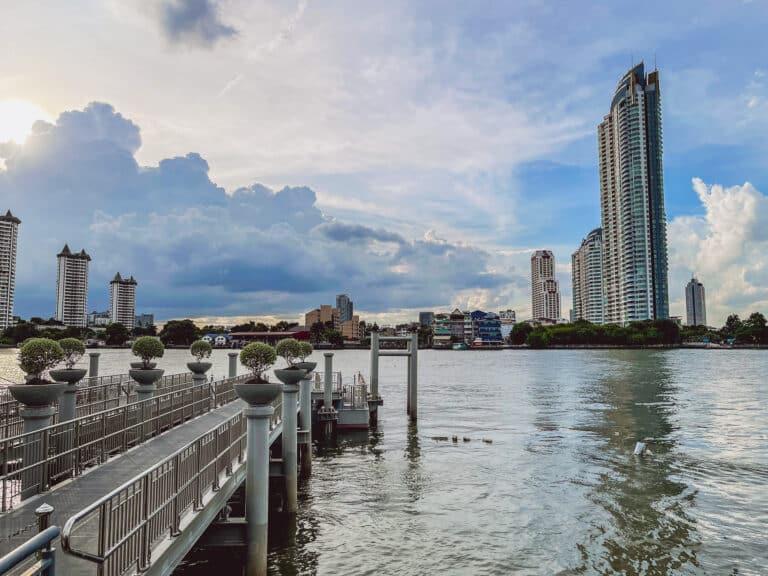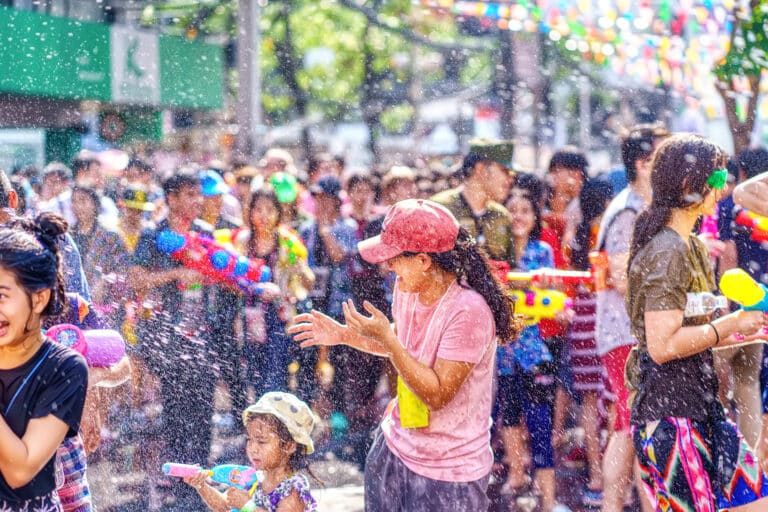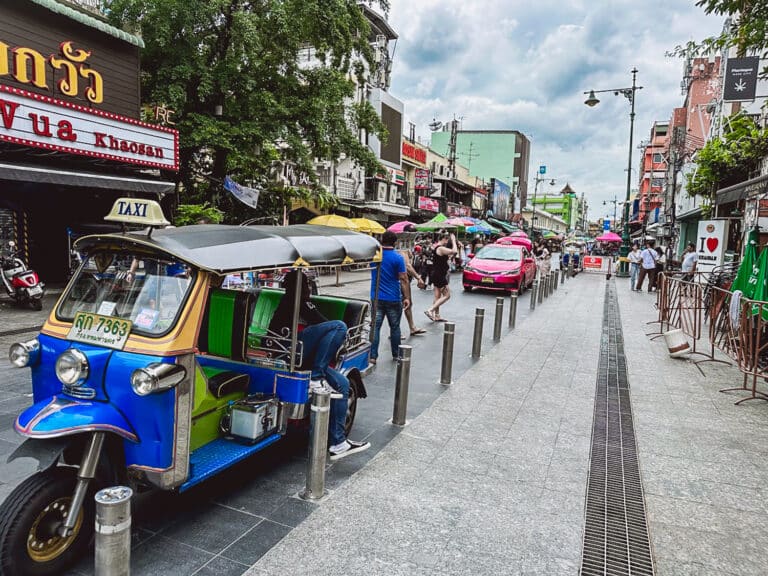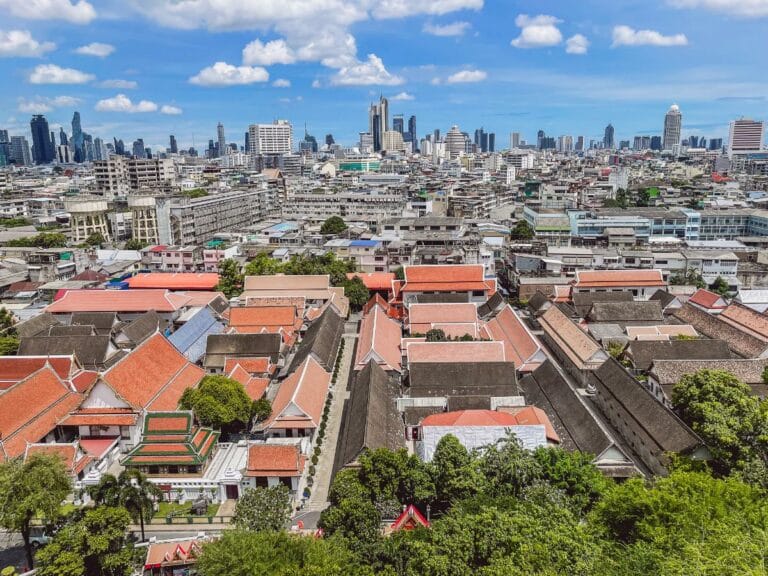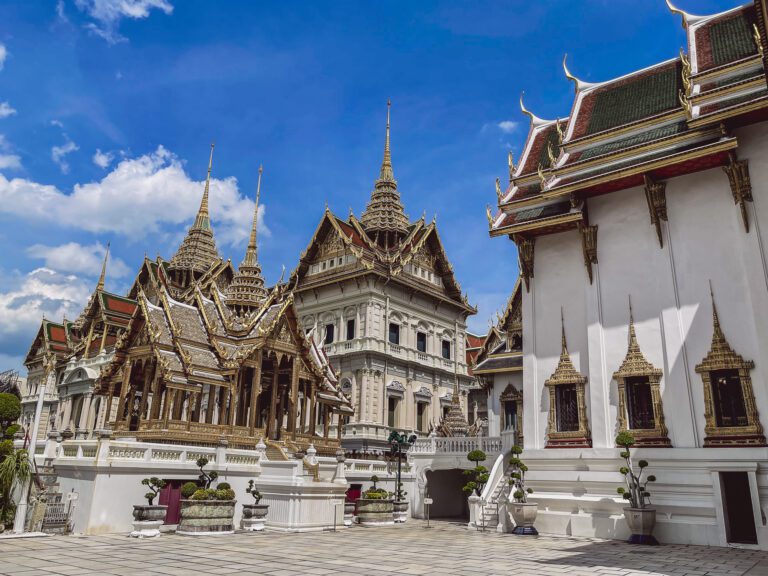Public Transport in Bangkok: How to Get from A to B in Comfort
Bangkok offers a very well-developed public transportation network that allows tourists and locals to explore the city quickly and cheaply.
Thanks to the well-developed network, you can easily reach almost all of Bangkok’s major sights and business districts.
In this article, we will give you a comprehensive overview of the various means of transportation in the Thai capital and how you can use them.
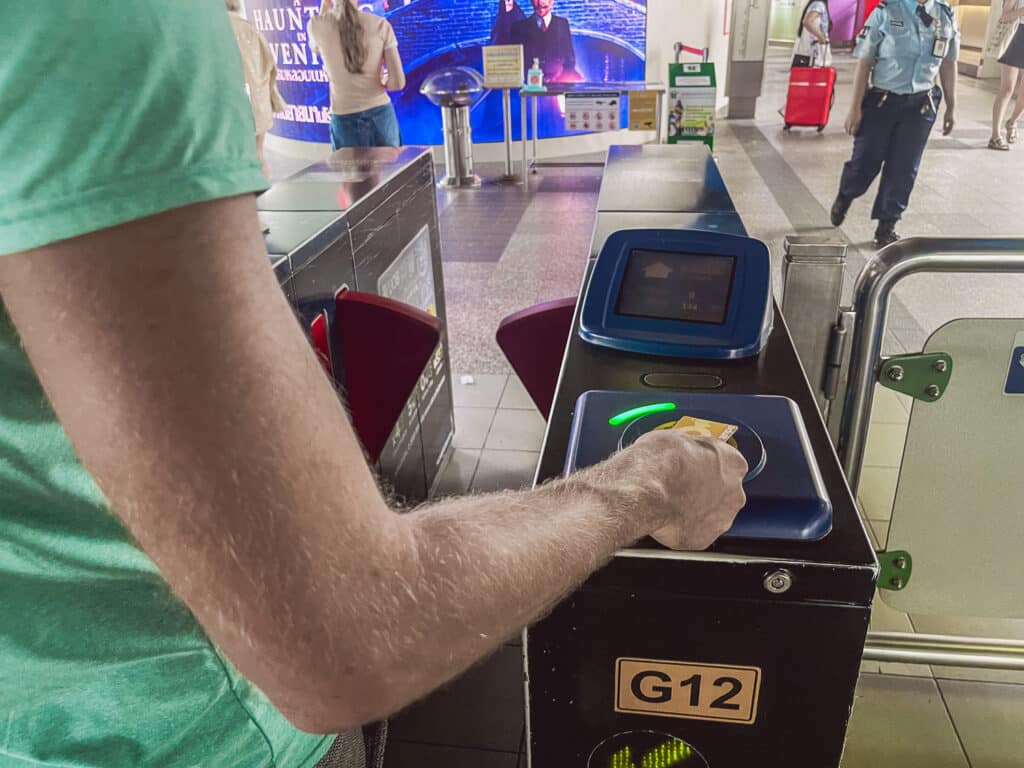
BTS Skytrain in Bangkok – Fast and air-conditioned connections above the city
The BTS Skytrain is one of the most efficient means of transportation in Bangkok and runs on elevated tracks that cross the dense road traffic.
It is air-conditioned and ideal for getting around in hot Bangkok. The Skytrain operates on two lines: the Sukhumvit line and the Silom line. Both lines connect central districts such as Siam, Sukhumvit and Silom.
The prices depend on the route and vary between 16 and 59 baht (as of 2024). There are vending machines at the stations that accept coins and ticket counters where you can buy day tickets.
A day ticket for unlimited rides is available for 140 baht and is worthwhile if you want to visit many different sights in one day.
The Skytrain runs daily from around 5:00 a.m. to midnight, and during rush hour the trains run at short intervals to cope with the crowds.
Important to know: You can currently only pay in cash and with coins at BTS machines. To save time queuing, you can get a Rabbit card with credit for a deposit of 100 baht and top it up with cash. You will need a passport to buy a Rabbit card.
Tip: Immerse yourself in Bangkok’s cultural and historical heritage. Visit the Grand Palace, the Temple of the Emerald Buddha, Wat Pho and Wat Arun.
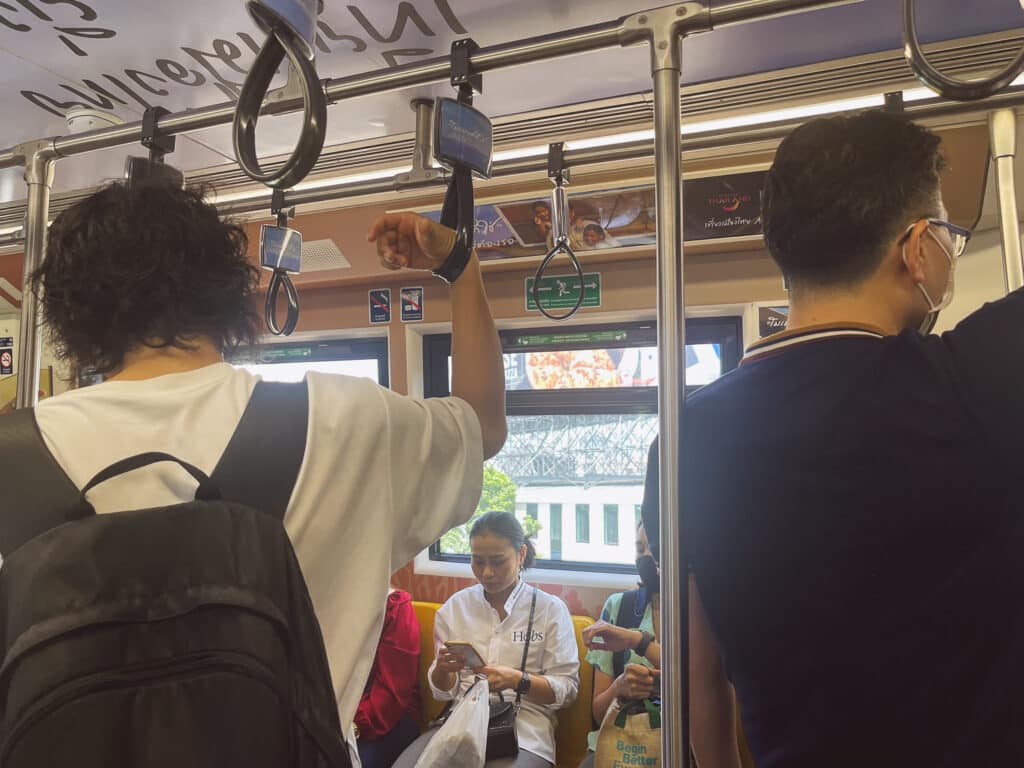
MRT Metro in Bangkok – Comfortably through the city
The MRT Metro complements the BTS network and serves both the Blue Line and the Purple Line. The Blue Line connects important tourist locations such as the Chatuchak Market and the old town of Bangkok with the modern city center.
The Purple Line extends further into the suburbs and is particularly useful for journeys off the main roads.
Here too, fares depend on the route and range between 17 and 45 baht (as of 2024).
Day passes are also available (150 baht, as of 2024) and allow you to easily use the metro for the whole day.
The MRT runs daily from 6:00 to 24:00. The trains are modern and air-conditioned, so you can also enjoy longer journeys in comfort.
Important to know: Unlike the BTS Skytrain, you can pay with cash or card at the MRT machines. Alternatively, you can simply present your credit card at the barrier.
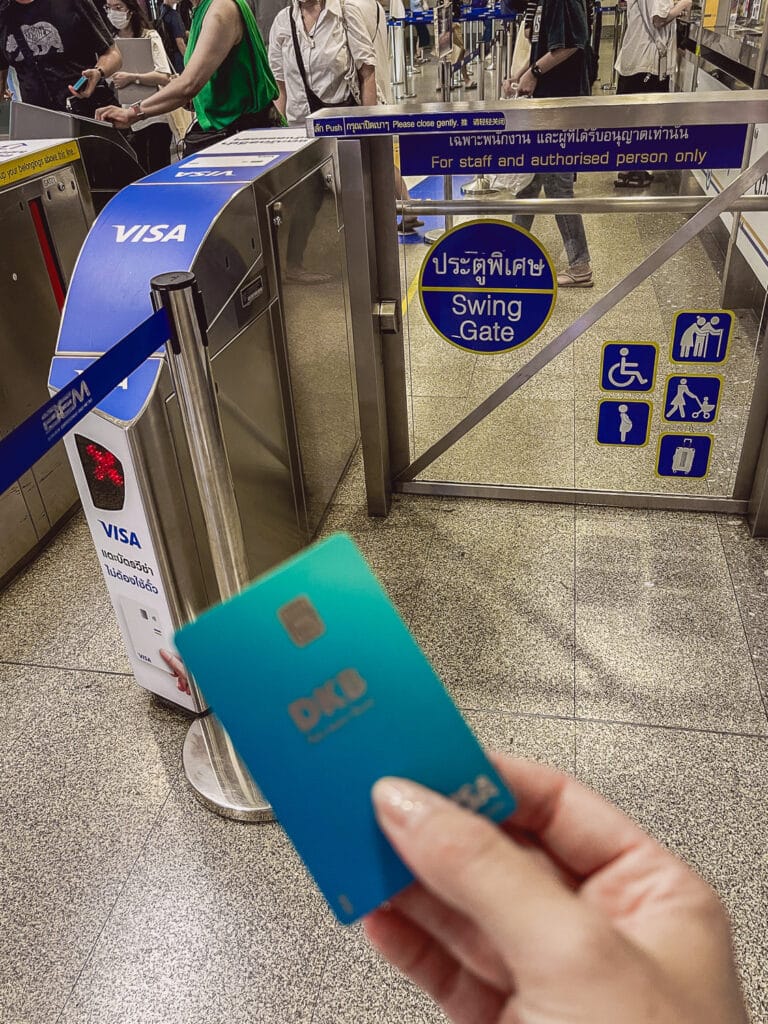
Airport Rail Link in Bangkok – From the airport directly to the city center
The Airport Rail Link connects Suvarnabhumi International Airport with the city center and is the fastest connection between the airport and Bangkok.
The trains run from 6:00 to 24:00 and depart every 10 to 15 minutes. You can easily take the Airport Rail Link to Phaya Thai Station and from there change to the BTS Skytrain or the MRT.
The Airport Rail Link also makes a stopover at Makkasan MRT station.
The journey takes between 15 and 30 minutes depending on the terminus and costs between 15 and 45 baht. There are vending machines at the stations that allow easy and convenient payments.
The Airport Rail Link is ideal if you want to avoid the traffic on the roads and get directly to the city center.
Tip: Discover Bangkok’s hidden gems on a bike tour through narrow backyards and alleyways.
Chao Phraya Express Boats – discover Bangkok’s waterways
The Chao Phraya Express boats are a particularly relaxing way to discover Bangkok from the water.
The boats operate on the Chao Phraya River and connect many important sights such as the Royal Palace, Wat Pho and Wat Arun.
They run from 6 a.m. to 6 p.m. and are a wonderful alternative to the heavy traffic on the roads.
There are different boat lines, which are color-coded and differ in their route and price.
One-way trips cost between 10 and 40 baht depending on the line (as of 2024). Tickets are available directly at the landing stages – if you can’t make it in time, you can also pay on the boat.
The boats offer an excellent opportunity to experience the city from a new perspective while avoiding the traffic.
Important to know: Don’t confuse the Chao Phraya Express boats with the Chao Phraya Tourist Boat. The latter is more expensive (30 baht/trip or 150 baht/day) and runs less frequently.
You can find the timetable here.
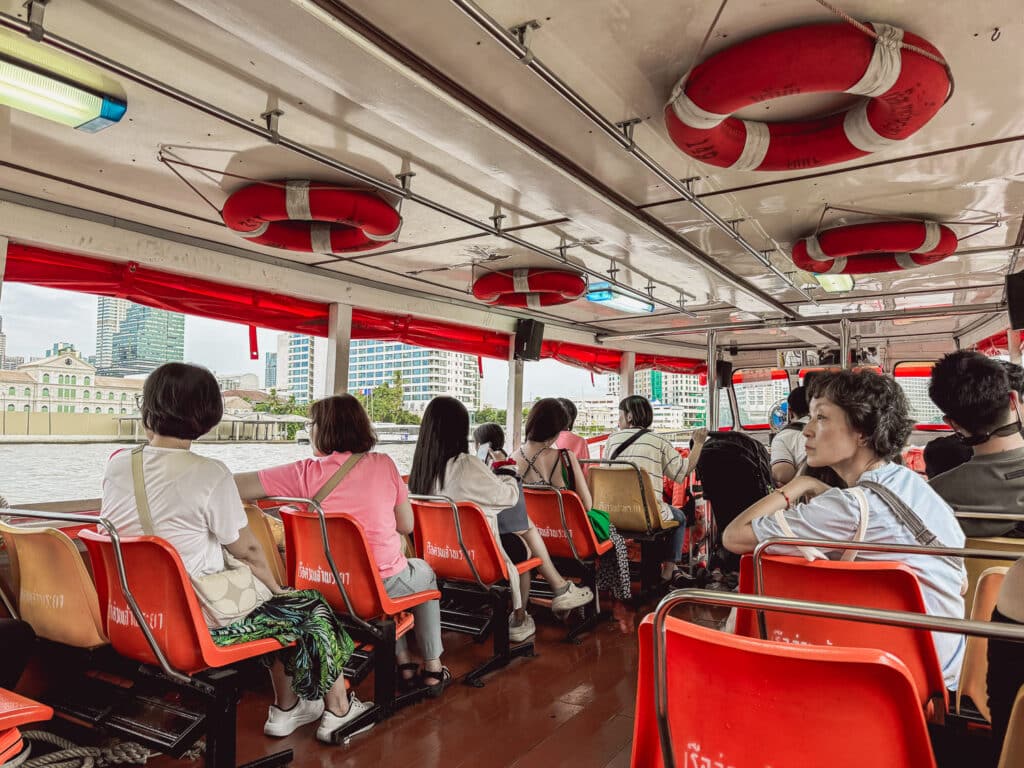
Khlong Saen Saep canal boats in Bangkok – fast through the canals
The canal boats on Khlong Saen Saep are a quick way to commute between Sukhumvit and the old town.
They run from 5:30 a.m. to 8:30 p.m. and are popular due to their speed, especially during rush hour.
However, the canal boats are not for the faint-hearted, as they are usually quite full and people get on and off quickly.
Fares range between 8 and 20 baht depending on the route (as of 2024), and tickets are issued directly when boarding.
The boats offer a fast, inexpensive and exciting alternative to other means of transportation, especially for commuters.
Tip: Hop on a typical Thai longtail boat and explore Bangkok’s canal life. This 2-hour canal tour gives you the opportunity to experience an original part of Bangkok.
Buses in Bangkok – Inexpensive, but time-consuming
The buses in Bangkok are the cheapest way to get around. Fares vary between 6.5 and 22 baht depending on the route and type of bus (as of 2024).
However, the buses are often in heavy traffic in the city and journey times can vary greatly.
Bangkok offers different types of buses: air-conditioned and non-air-conditioned, red buses, which are cheaper, and blue and yellow buses, which offer more comfort.
The bus routes cover large parts of the city, and Google Maps is helpful in finding the right route.
For tourists who are not in a hurry and want to experience the city authentically, the buses are an exciting option.

Cabs and tuk-tuks in Bangkok – flexible, but not always cheap
Cabs are a convenient way to explore Bangkok. It is important to always insist on the taximeter to pay fair prices.
The basic fee is around 35 baht (as of 2024), and additional costs are incurred for each additional route.
During rush hour, many cab drivers refuse to turn on the taximeter. If you cannot find an alternative, we recommend that you fix the price in advance.
Tuk-tuks, the iconic three-wheeled vehicles, are also a popular option for short distances. However, they do not have a fixed price, so here too it is important to negotiate the price in advance.
Cabs and tuk-tuks are particularly practical for short distances or for places that are not directly served by public transport.
They are more flexible, but generally more expensive than local public transport. Tuk-tuks are also a unique experience and give you the feeling of experiencing a piece of traditional Bangkok.
But be careful: the drivers’ original price suggestions are often astronomical, so you should definitely bargain here. A few black sheep will also try to drive you to souvenir stores.
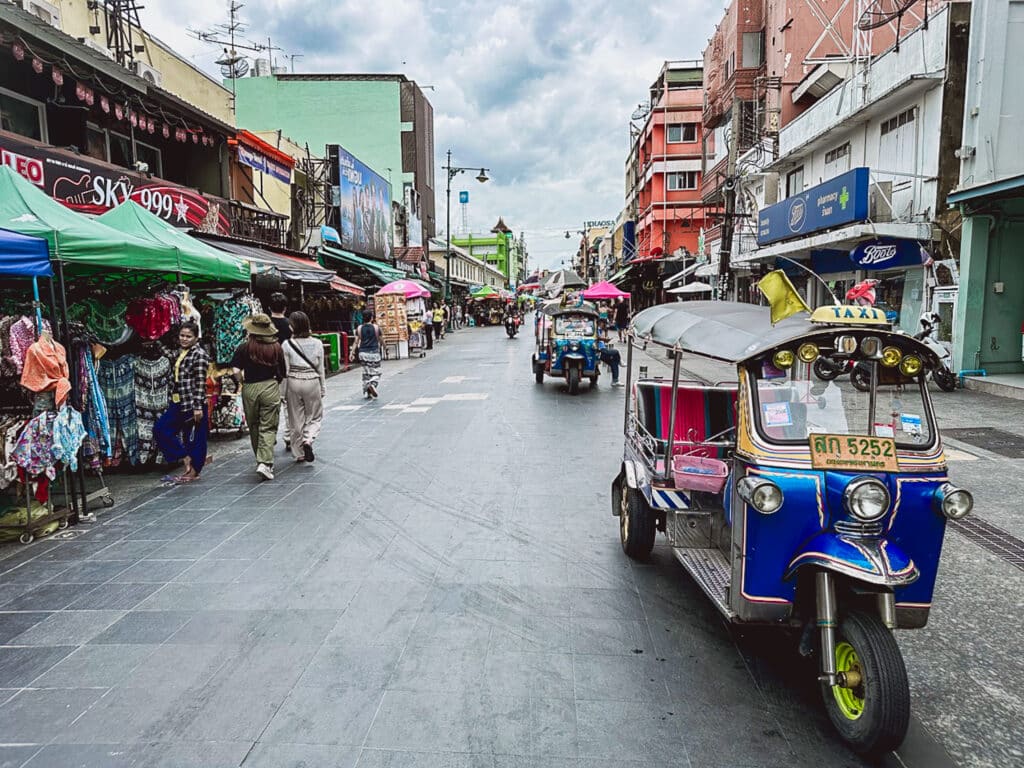
Motorcycle cabs – For short distances and fast progress
Motorcycle cabs are ideal for short distances and when time is of the essence. They can be found particularly in the narrow sois (side streets) and offer fast transportation through the heavy traffic.
Prices for motorcycle cabs vary depending on the route (from around 20 baht), and here too it is advisable to clarify the price in advance.
They are an inexpensive and quick alternative, but not necessarily the safest choice.
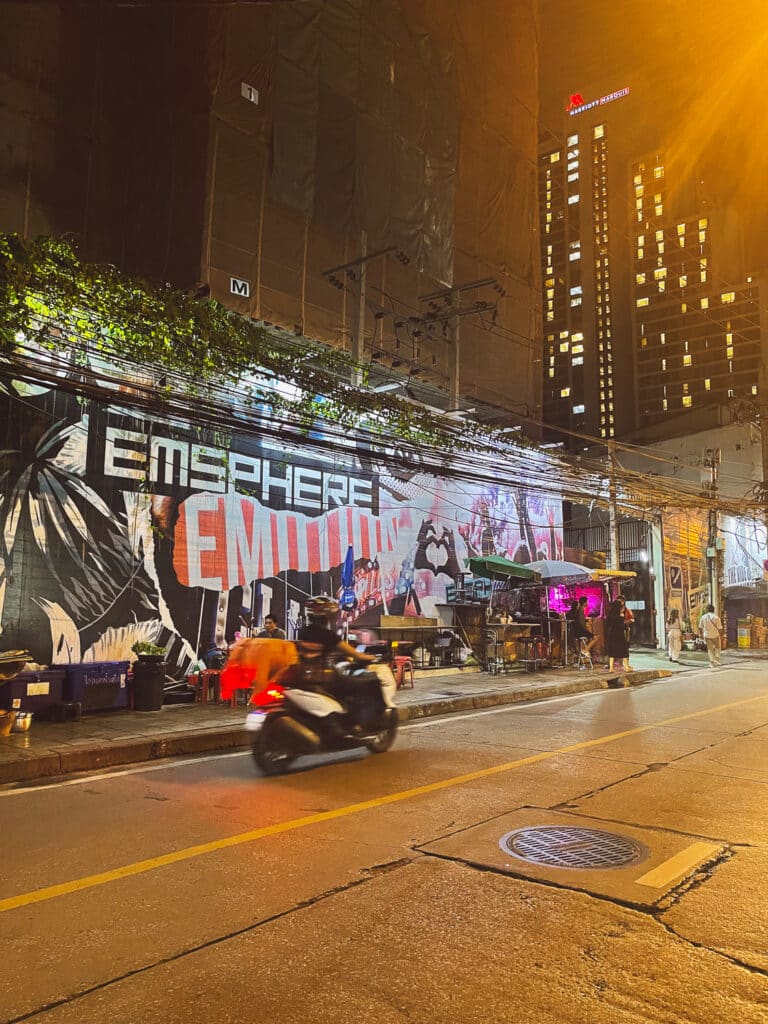
Ride apps in Bangkok – Bolt, Grab & Co.
Using ride apps in Bangkok is a convenient and efficient way to get around the bustling metropolis.
In a city known for its dense traffic, ride-hailing services such as Grab, Bolt and Gojek offer a flexible alternative to traditional cabs and public transportation.
These apps allow you to book rides quickly and easily without having to search for a free cab or negotiate the price.
1st Grab – The top dog among ride-hailing services
Grab is one of the most popular and well-known ride-hailing services in Bangkok and Southeast Asia. The app not only offers transportation services, but also food delivery (GrabFood), parcel services and even a shopping function (GrabMart).
Grab has become one of the preferred platforms for many locals and tourists due to its reliable service, variety of vehicle options and fast support.
Grab offers various types of vehicles, including:
- GrabCar: Private limousines or standard cars.
- GrabBike: Motorcycle cabs, ideal for fast, short routes through dense city traffic.
- GrabTaxi: Taxis that can be ordered directly via the app.
The app also offers price overviews so that you can see the fare in advance. You can pay conveniently by credit card, GrabPay or cash.
2. bolt – low-cost alternative
Bolt is another ride-hailing app that is becoming increasingly popular in Bangkok. Compared to Grab, Bolt is often cheaper and offers equally easy booking of rides.
Bolt focuses on fast journeys through traffic and mainly offers cars and motorcycle cabs. Bolt scores with attractive prices, which are particularly advantageous for longer journeys.
3rd Gojek – More than just rides
Gojek is an Indonesian super app that has also gained a foothold in Bangkok. Similar to Grab, Gojek not only offers driving services, but also food delivery and parcel services.
Gojek relies primarily on its GoRide motorcycle cabs, which are particularly practical for getting around Bangkok’s dense traffic. GoCar is Gojek’s counterpart to conventional car transportation.
Gojek also offers transparent pricing and flexible payment options such as credit cards, mobile wallets or cash.
Prices and availability at Ride Apps
The prices for the ride apps depend on the time of day, the route and the traffic situation. Prices may be higher during rush hours or when demand is high (surge pricing).
Still, the apps are an affordable option for transportation in Bangkok, especially compared to traditional cabs, which sometimes charge higher prices or refuse to turn on the meter.
All three apps are available for both Android and iOS and are easy to download and use.
They also offer the option of booking rides in advance, which is particularly useful if you want to get to the airport or an event with a fixed time.
Important to know: At peak times and on longer routes, some drivers will send you messages and try to drive up the price – even though they are not actually allowed to do this according to the Ride App rules.
If you do not agree to this, write this clearly and insist that the drivers cancel the trip themselves in the app – otherwise you could be subject to cancellation fees.
Tip: On this guided tour through Chinatown you will see Wat Traimit and the most exciting corners of the district.
Tips for using public transportation in Bangkok
- Day tickets and passes: Day tickets are available for the BTS Skytrain and the MRT, which are worthwhile if you are planning several trips in one day. This allows you to stay flexible and explore the city with ease.
- Avoid rush hour: Traffic is heaviest between 7:00 and 9:00 am and between 5:00 and 7:00 pm. If possible, plan your trips outside these times.
- Navigation by app: Google Maps or the special Bangkok navigation apps are helpful for finding the best routes and travel times.
Thanks to the diverse means of transportation, you can explore Bangkok flexibly and easily.
From the BTS Skytrain and MRT to the waterways and iconic tuk-tuks, the city offers something for everyone and makes traveling easy and exciting.
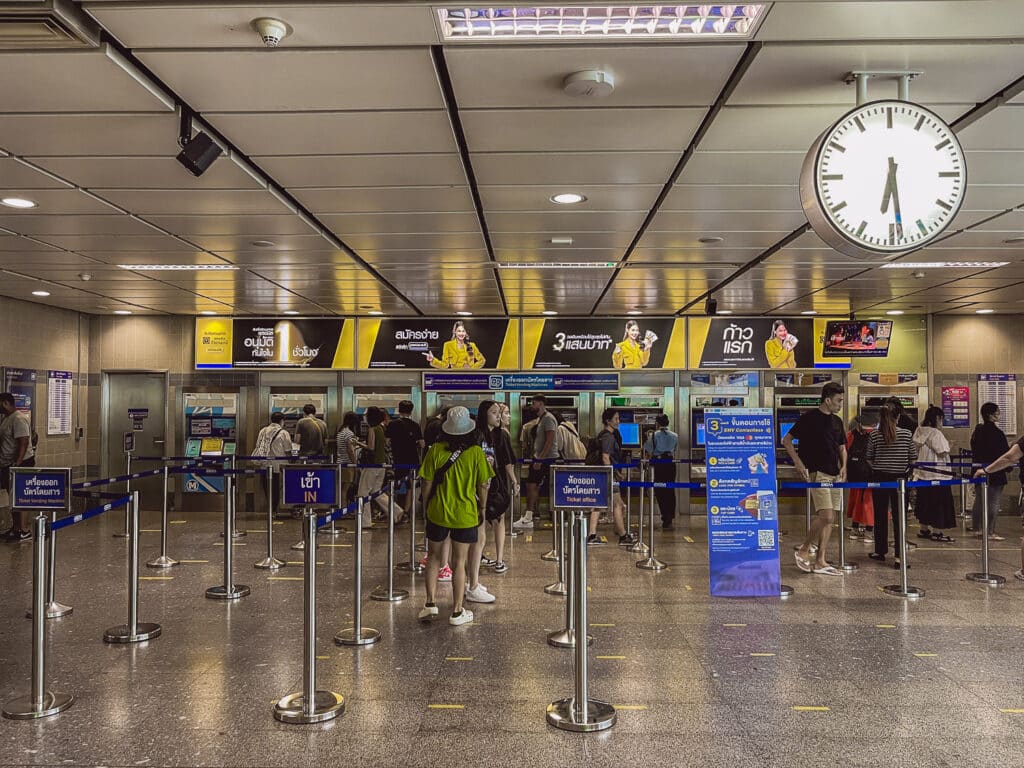
Frequently asked questions about public transportation in Bangkok
Finally, we will answer a few frequently asked questions about public transportation in Bangkok.
What types of public transportation are available in Bangkok?
Bangkok offers a variety of public transportation options, including the BTS Skytrain, the MRT subway, public buses, tuk-tuks , cabs, motorcycle cabs and river cabs on the Chao Phraya. These systems allow for quick transportation around the city, depending on your preferred speed and comfort.
How does the BTS Skytrain work?
The BTS Skytrain is a modern elevated train system that spans two main lines: the Sukhumvit and Silom lines. The trains are air-conditioned and offer a quick way to cross the city without traffic jams. Tickets can be purchased from vending machines at each station or used via a rechargeable Rabbit Card.
What is the MRT in Bangkok and how does it differ from the BTS?
The MRT is Bangkok’s subway system, which runs mostly underground. It includes the Blue Line and the Purple Line. The main difference with the BTS is that the MRT runs under the city, while the BTS runs above the city. However, both systems are well connected and offer transfer options.
How safe is public transportation in Bangkok?
Public transportation in Bangkok is generally very safe. The BTS and MRT are considered particularly safe and are regularly maintained. However, you should be more careful with buses, cabs or motorcycle cabs, especially during rush hour or when there are tourist traps such as inflated prices.
How do I pay for travel on the BTS or MRT?
One-way tickets for individual journeys can be purchased from ticket machines (BTS currently only with cash). There is also the Rabbit Card for the BTS and the MRT Plus Card for the MRT. These cards can be topped up and enable quick and easy payment when boarding and alighting. At the MRT stations, you can also simply present your credit card at the barrier.
How expensive is public transportation in Bangkok?
The cost of public transportation varies depending on the means of transport. A ride on the BTS or MRT costs between 16 and 59 baht, depending on the distance. Public buses are cheaper, often between 8 and 20 baht, while tuk-tuks and occasionally cabs have to be negotiated depending on the route.
How does bus transportation work in Bangkok?
Bus transportation in Bangkok can seem a bit chaotic as there are many lines and different types of buses, including air-conditioned and non-air-conditioned. There are also different fares, ranging from 8 to 20 baht. Bus timetables are often in Thai, and the stops are not always clearly signposted, which is why apps such as Google Maps or Moovit can be helpful.
Is it easy to use public transportation in Bangkok as a tourist?
Yes, tourists can easily use public transportation in Bangkok. The BTS and MRT offer announcements in English, and most signs are bilingual. However, for buses, cabs and tuk-tuks, it can be helpful to have some basic knowledge of Thai or to present the destination address in writing.
9. what are the main transportation links for tourists in Bangkok?
The Sukhumvit Line of the BTS is particularly important for tourists as it passes by many popular places such as the Siam shopping district, Chatuchak Market and the Thonglor area. The MRT Blue Line is also important as it provides access to attractions such as Wat Pho and the Grand Palace.
Which apps are useful for finding your way around public transport in Bangkok?
Useful apps include Google Maps to plan routes, BTS Skytrain to get up-to-date information about the Skytrain and Moovit to find bus routes. Grab or Bolt are also recommended to call motorcycle cabs or cabs.
